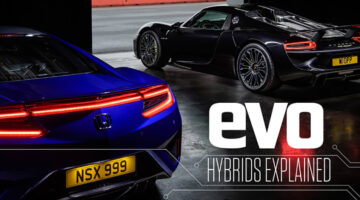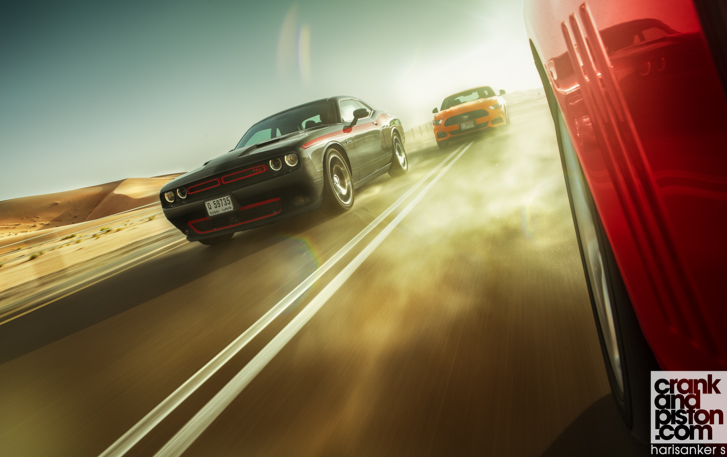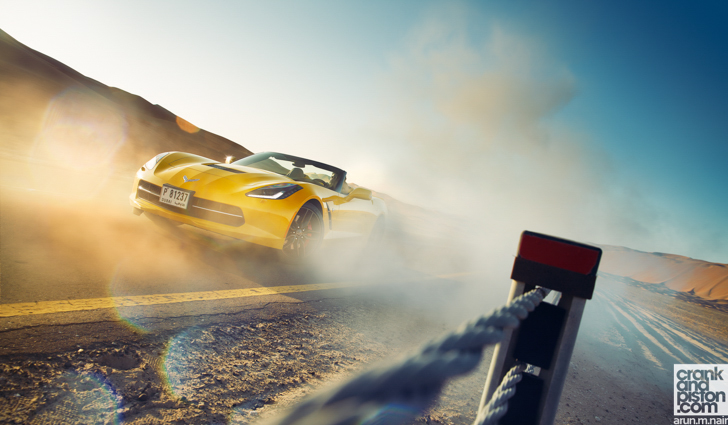The ultimate Camaro question: 2017 SS or 1969 Z/28 Tribute? I’ll admit, it’s tricky. We let our inner children off the leash on this one ..
Hits me first, a shockwave of raw mechanical fury that gently crescendos into a raucous note of barely contained anger. Even more impressive is the manner in which this note, as the wheels start to turn and the revs begin to rise, tries to rattle the windows from their frames.
Somehow, this 1969 Camaro Z/28 Tribute manages to do all this whilst the aggressive note of the 2016 Camaro Six in which I’m sitting barely registers.
It’s late afternoon on a quiet stretch of tarmac just outside the city limits, and while crankandpiston photographer Arun ponders his next frame, ’69 Z/28 owner Rob and I let our inner children off the leash and practice the best smoking starts we can muster.
It’s a whitewash. The revised 6.2-litre ‘LT1’ V8 that comes as standard in the SS model we’re testing today – more on that in a second – punches out 449bhp and 455lb ft of torque, enough to hit 0-100kph in just over four seconds. Rob’s Z/28 meanwhile houses a similarly large 5-litre V8 (albeit one from a 1986 model courtesy of a previous owner) that produces ‘around’ 290bhp, impressive by 1960s standards but on par with a factory spec Ford Focus ST today. Then again, times have changed considerably since the Camaro name emerged 50 years ago.
Debuting in September 1966, the Camaro was unleashed on the public the next year with one clear bulls-eye in-mind – Ford – at a time when the pony car craze, plus the ‘rebellious’ aura that went with it, was starting to take hold: when asked about the former Panther concept’s new name, motoring journalists were simply told that a Camaro ‘was a vicious small animal that devours Mustangs.” It’s intent was clear, and pretty soon the rear-driven, front-engined replacement to the Unsafe at Any Speeds Corvair was jostling the Mustang for sales supremacy.
Among the biggest selling points, at a time when ‘Race on Sunday, Sell on Monday’ was still salient, was the newly established SCCA Trans-Am Road Racing series, a championship that, by 1967, had every major pony car represented by a factory outfit. Though floundering interest in the segment, rising costs and significant technical regulation change meant most manufacturers were gone by 1970, it would be Chevrolet that ultimately dominated the series’ golden era’.
The company’s performance-focused Camaro Z/28 – built specifically with a 302cu in engine and aerodynamic upgrades to compete with the Mustang on-track – dominated en-route to championship wins in 1968 and 1969 with the help of American racing giant Roger Penske. It’s no coincidence that, during this period, the road-homologated Camaro Z/28 outsold the Boss Mustang 302, 20:1.
Like I said though, times have changed since the muscle car’s heyday.
Indeed, with Chevrolet striving for even greater performance and refinement in a segment it once called its own, the weight of expectation lies heavily on the new Camaro Six. Bar the rear ‘bowtie’ logo and ‘SS’ badge on our test model, nothing of the fifth generation has made the jump. Indeed, up to 350 hours of wind tunnel testing has been implemented into that rakish bodywork alone, the Camaro Six also featuring a leaner, stiffer chassis (70 per cent of which is unique to the Camaro), and the 6.2-litre ‘LT1’ V8 that’s essentially been plucked from the Corvette Stingray. Even despite a plusher cabin, which I’ll come back to, Chevrolet has also managed to rid 90kg of the overall weight and improve rigidity by 28 per cent. Make no mistake, with the new Camaro Six, it’s all about the performance. Well, almost.
Parked as we are on this deserted stretch of tarmac, Arun having now told us to stop playing silly buggers because the light is perfect, what strikes me most about the Camaro Six are the looks. At the front are much sleeker headlights that emit a grace that somehow doesn’t lessen the impact of that enormous power bulge or the colossally sized air vents in the front bumper. For added visual whollop, our SS model also receives bespoke 18in alloys and a unique rear spoiler at the rear. It’s a look that’s, somehow, both graceful yet aggressive, a presence that admittedly the Z/28 runs close with its retro charm.
Rob and I are in agreement, the racing stripes – a standard feature on the Z/28 since the beginning – just bring the car to life, as does the more rounded bodywork and sunken headlights alongside the front grille. The 15in wheels, albeit on imported road-rally tyres, and the occasional ‘Z/28’ badge seem almost subtle by comparison, but there’s little question this first generation model is just as much the head-turner as it was five decades ago. It’s little wonder the fifth gen Camaro leant heavily on its design when the model was re-introduced in 2009.
Tempting as it is to stand and wax both lyrically and exhaustively on the subject, time isn’t on our side this afternoon. The summer heat and humidity may not affect the SS, but the 48-year old Z/28 requires a little more care and consideration: Rob admits that the car rarely leaves the garage in the summer months, today being an exception as a personal favour to crankandpiston.com. Not only that but he also needs to pick up his son in a couple of hours time, “so we really do need to crack on.” On to the drive.
A couple of small coughs from the small block V8 means Rob has to give the Z/28 a quick run to calm things down, so my first run is in the SS. I’ve no objections to that though. True, the more compact Camaro Six is shorter in all directions than its predecessor, meaning the steeped roof and shoulder lines feel even snugger than they previously did: at just over six-foot tall, I have to angle my seat quite far back to find a comfortable/usable driving position. Handsome as it might be, the slicker bodywork means visibility over both shoulders and through the rear are also more challenging than ideal, but as I quickly discover, the new Magnetic Ride Control suspension – available for the first time on the Camaro – and the well-rounded Recaro seats mean comfort is actually pretty good for a modern day muscle car.
So too for that matter is the cabin, the badly dated setup in the predecessor having been out and replaced it in its entirety. Visually, all leather, soft plastics and the occasional chrome detailing, it’s a significant improvement, albeit one not without issues. The new centre-mounted touchscreen for instance is angled down, a sound idea to stop glare from the noon-day sun, but not overly practical from my driving position. The quality of cabin materials also takes a dive when you move away from the beautifully minimalist centre stack, and although the bolsters that run down the transmission tunnel are a neat addition, more often than not I just end up clouting my knee off them. Still, the forward-mounted gear-lever is considerably easier to use, and there’s now room for two Big Gulp cup holders.
Whilst I’ve been prattling away with the new generation MyLink infotainment system (and secretly wondering if both a dozen buttons and a touchscreen are really necessary), Rob is already gingerly on his way in the Z/28. Still, it’s a lead that’s eradicated with one bootful of throttle in the SS, the semi-furious grunt igniting 444bhp and a bulbous 455lb ft torque. Impressive initial pick-up soon cascades into a tangible shove of forward momentum, the V8 itself only starting to run out of steam when you’re well into 6000-7000rpm territory.
The new eight-speed gearbox meanwhile proves surprisingly slick at hurling power and torque at the rear wheels, and while it’s still not the most lightning of gear-changes, it’s a significant improvement on the out-going generation and still more than sharp enough to keep the V8 in the bubble.
Unsurprisingly, it doesn’t take long to overhaul Rob in the Z/28 and steam into the first corner ahead. Here I had expected, like the previous generation, for the chassis to struggle reigning in that heavy V8. Indeed, barrelling into the first turn, the newly lowered weight distribution can’t fully hide the lightest stirrings of pitch as the nose ‘nods’ its way to the apex. Having said that, the newly polished chassis seems completely unruffled under load, the extraordinary amounts of grip offered by the front tyres and some enormously impressive stability preventing the bowtie from breaking and washing wide, allowing me to jump back on those fierce reserves of power and torque earlier.
It’s a similar situation into and out of the next sequence of corners, where, renewed confidence thanks to enormous stopping power from the Brembo discs, despite some slight snatchiness, encourages me to send the front end deeper into the turn. Clearly it’s going to take more to overwhelm this chassis.
The steering must take its fair share of credit here too. Granted, there isn’t quite the sense of feedback I’d desire of a portly 1697kg sports car and the flat-bottomed configuration can prove awkward to handle on full lock. But there’s well-damped weight through the wheel and an impressive amount of precision.
Even with this new agility, there’s enough lairiness remaining at the rear axle – over which you’re effectively sitting – to keep that muscle car DNA alive. The rear wheels need little incentive to light up, a raucous ‘bark’ of V8 anger being fed into the cabin in the process. Similarly, mid-corner yaw can very easily turn into controllable, yet smoking, arcs of oversteer when you allow the rear axle off the leash.
I will admit though, much like the new Ford Mustang before it, the amount of agility under turn-in, plus the premium confines I find myself wrapped in, does work against the Camaro’s innately blue collar ‘muscle car’ DNA, and it’s not long before I begin considering the SS more sports car than pony, something I doubt early 1960s Detroit would find forgivable. It’s not a concern though for the Z/28, once the SS pulls to a stop and Rob finally manages to catch up. This ’69 classic is muscle car to the bone.
- Story continues on page 2



